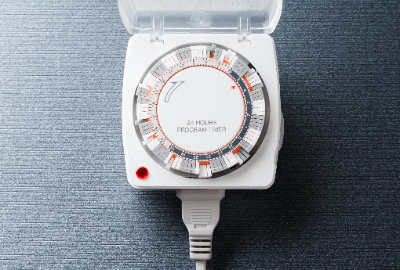What Is a Program Timer?

A program timer is a device that turns an electrical appliance ON and OFF at predetermined times.
Typically, a program timer operates such that it turns on at the same time each day and then turns off at a set time thereafter. Some models offer multiple ON/OFF timing combinations.
For instance, Mondays might be controlled by Pattern A’s ON/OFF timings, Tuesdays by Pattern B’s, and so on with Patterns C, D, E, etc. Users can choose which program to activate on each day of the week.
Uses of Program Timers
Program timers are commonly used in lighting systems and home appliances.
1. Basic Uses
A program timer can, for example, turn on a light at the same time every day and turn it off at a preset time, or operate a humidifier from morning until a predetermined bedtime.
2. Advanced Uses
Beyond basic operations, recent models include additional features. For instance, a light sensor might turn a device on when it’s bright and off when it’s dark, ideal for applications requiring operation only during daytime.
Models vary from waterproof outdoor types to those displaying the electricity usage of connected devices. Prices range from about 1,000 yen for basic models to over 10,000 yen for advanced models.
Principle of Program Timers
Program timers typically have an AC outlet for 100 VAC input and another for connecting the controlled electrical appliance. They work by conducting power between these outlets at the set ON time.
Simple timers operate daily at specific times with basic logic circuits. More advanced timers, with multiple programs, operation buttons, and an LCD, often incorporate a microcomputer.
Program Timer Configuration
A Program timer consists of four main components: power supply, input, timekeeping, and output.
1. Input Section
The input section receives signals from input devices and forwards them to the timekeeping section.
2. Timekeeping Section
This section measures time and signals the output section when the user-defined time elapses.
3. Output Section
Upon receiving a signal from the timekeeping section, the output section activates the connected device.
The program timer uses these components to generate an output signal at a predetermined time after receiving an input signal.
How to Select a Program Timer
1. Allowable Power
Program timers have varying power limits. Ensure the power required by the connected device is within the timer’s capacity.
2. Operation Pattern
When selecting a program timer, consider the required operation pattern and number of settings. Options include countdown functions for time-based ON/OFF control or specific time settings.
The number of operations refers to the number of programmable patterns or times; some timers allow setting multiple operations, while others are limited to one.
3. Error Margin
The accuracy of program timers varies. Some sync with servers for minimal error, while others may have a daily error margin of about 10 minutes.
4. Water Resistance
For outdoor use, water resistance is crucial. Most general products lack waterproofing, so selecting a model with rainproof features is essential.